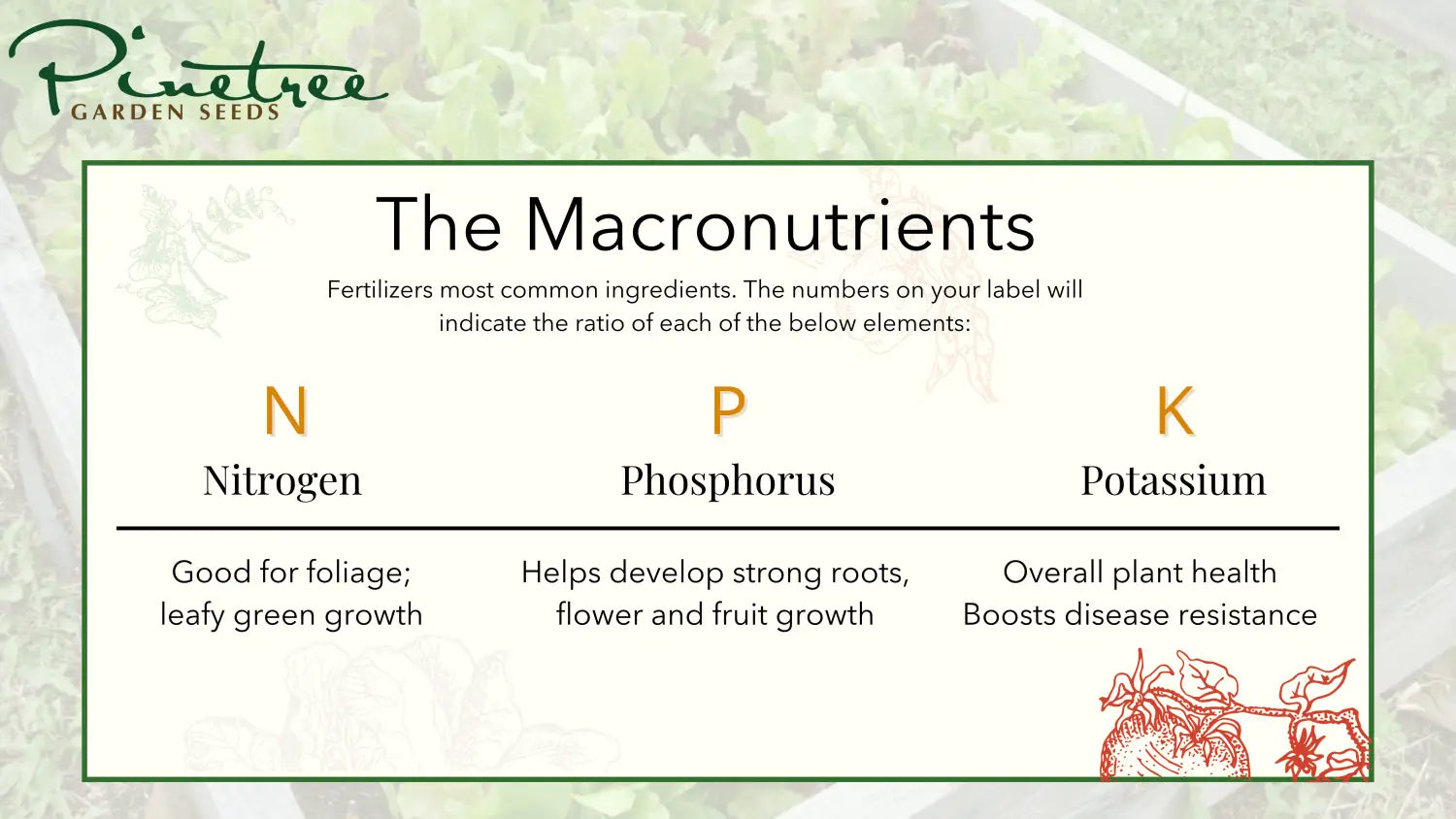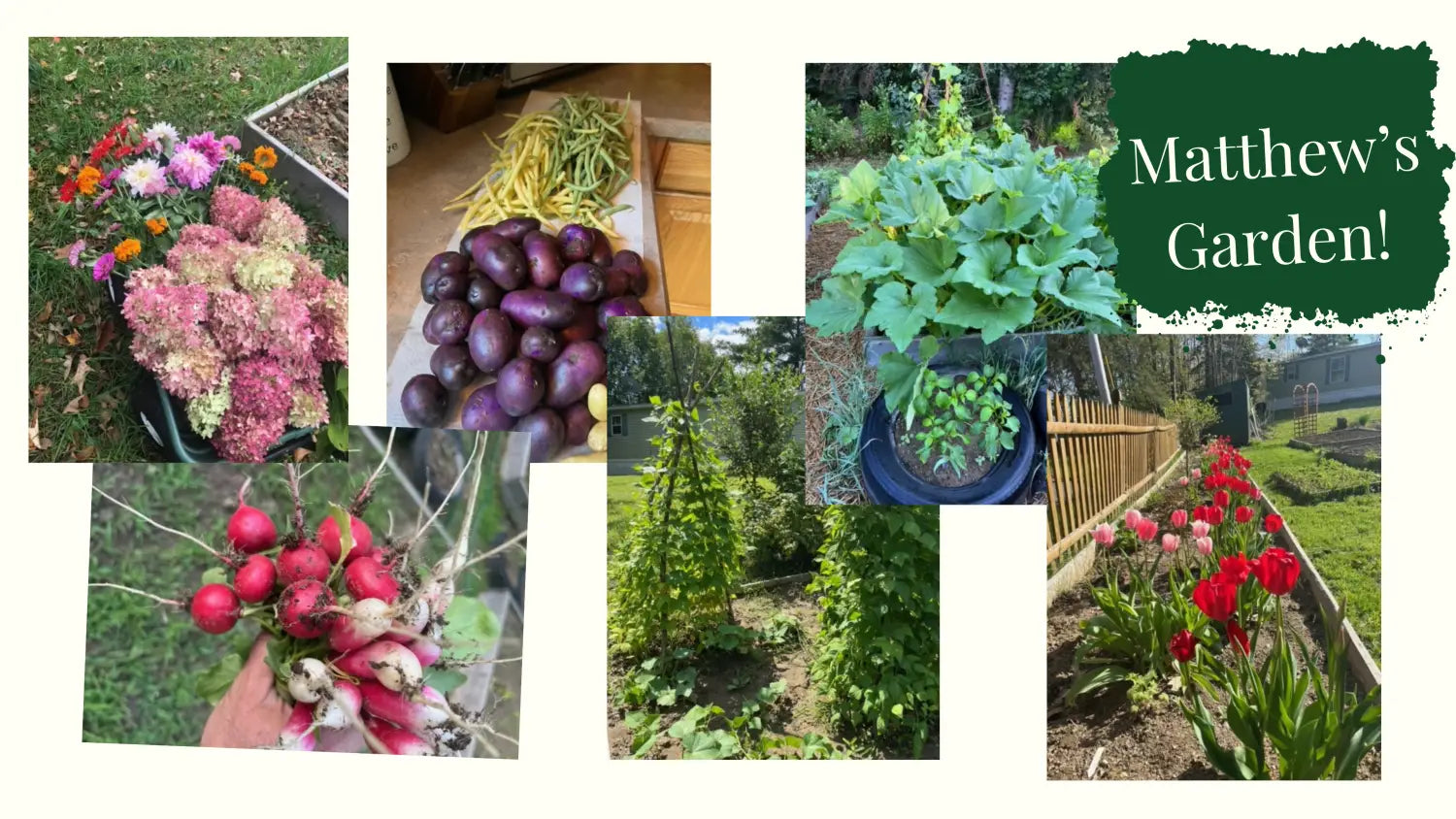“Gardening; where every failed experiment is just fertilizer for success”
- shared with us by Evelyn, a member in our Facebook group Rooted
Boost Your Garden’s Growth Naturally
Fertilizers provide essential nutrients that your plants need to grow strong and healthy. Whether you’re growing a small herb garden, nourishing a lush vegetable bed, or feeding your flowers, choosing the right amendments and fertilizers can make all the difference. At Pinetree, we strive to boost organically using naturally derived ingredients because what feeds our seed makes a happy garden indeed!
How to Choose the Right Fertilizer

Download PDF
The Basics:
All fertilizers will have 3 key numbers on the package that represent the ratio of the top ingredients: N-P-K; Nitrogen (N), Phosphorous (P), and Potassium (K).
- Nitrogen is good for your foliage, encouraging good, leafy green growth.
- Phosphorus helps develop strong roots and encourages blooms and fruit development.
- Potassium is excellent for your overall plant (and soil) health! It strengthens the plants defenses boosting disease and stress resistance.
What your plants need will vary based on what's currently in your soil.
Not sure what you're working with? Use a soil tester like the Rapitest 4-Way Analyzer or the soil test kit - or send a sample of your soil to your Local Cooperative Extension!
Vegetables and Fruits benefit from nutrient-rich options like earthworm castings and guano for robust growth and high yields that typically have a balanced ratio of NPK. Flowers love phosphorus-heavy fertilizers like fish bone meal to enhance blooming. And if you're just looking to better your general soil health, a mix of organic matter, such as compost enriched with earthworm castings or guano, can improve overall soil fertility, increase water retention, and promote microbial activity - putting the good bacteria and organisms to work!
Top Natural Fertilizers for Your Garden

Download PDF
1. Earthworm Castings:
- Elevate the soil structure by making it more aerated and improve water retention.
- They're a 'slow-release' nutrient source which supports sustained plant growth so your plants can feed overtime.
- They enhance microbial activity, promoting a healthier soil ecosystem.
How to Use: Mix 10-20% castings into your soil, use as a top dressing, or brew into a nutrient-rich worm tea.
2. Guano:
We know it sounds, less than appealing but trust us, guano happens! And this stuff is garden gold:
- It offers a fast-acting nutrient boost making it ideal for stimulating plant growth during critical periods.
- It'll speed up your compost pile! Guano acts as a compost activator speeding up decomposition.
- It enhances soil structure and promotes microbial activity.
How to Use: Apply guano as a soil amendment or mix it into compost for an extra nutrient kick.
3. Fish Bone Meal:
Fish bone meal is an excellent source of phosphorus and calcium, crucial for root development and flowering. It:
- Improves soil structure and increases microbial activity.
- Provides a slow-release supply of nutrients, supporting long-term growth.
- Recycles fish industry by-products, making it a sustainable fertilizer choice.
How to Use: Incorporate fish bone meal into your soil or use it as a top dressing around plants.
4. Calcium
Often included in a typical mix, calcium amounts will vary fertilizer to fertilizer and should be chosen based on your specific plants needs. Tomatoes, peppers, lettuce, cabbage, and legumes can thrive with a boost in calcium. But! too much might hurt your soil- be sure you test and understand your pH levels before selecting a calcium enhanced mixture.
- Calcium boosts cellular health helping to prevent fruit splitting
- Aids in healthy plant tissue development producing stronger, juicier fruits.
Tips for Applying Fertilizers
- Test Your Soil: Understanding your soil’s nutrient levels helps you choose the right fertilizer and apply the correct amount. More info HERE
- Different feeds for different seeds: Your plants have different needs; some are heavier feeders, some need more calcium, and amending for leafy growth is different than amending for fruit production.
- Follow the directions! We know (eye roll) but every fertilizer is a little different and fertilizers can be potent! Make sure you check with your specific product instructions before fertilizing your precious plants.
- Water well: Water your soil before and after you fertilize to prevent any root burn and help your nutrients spread.
- Know how to 'side dress': Side dressing is applying fertilizer to the side of your plant to prevent root burn. Most nutrient absorption happens through the roots so side dressing with fertilizer is the best way to ensure your plants can properly feed without risking burning the plants themselves. Be sure to follow the directions on your packaging, but typically, most side dressing tips suggest applying fertilizers at least 6 inches away from the base of the plant.
Every time you harvest, prune, and remove any plants from your garden beds, you’re taking the nutrients with you so it's important to amend and fertilize throughout the growing season; from seed to harvest.
Brad (General Manager and gardener extroardinaire) preps his raised vegetable beds in early spring by mixing 1 - 2 lbs (2.5 - 5 cups) of our Down to Earth All Purpose Fertilizer into the top 3-4 inches of soil. "It gives my new seedlings a great start!"




Very good tips!
I live in a condo, with some access to plant some of our herbs and veggies in containers on our deck, patiio and a 10-20 plot we rent.
I started planting when I was 10 yrs old some 69 years ago. I never stopped, and worked with my wife, to enhance our ability to garden over the yrs. I had work as a child thru 4H and on local farm farms to gain my knowledge .
I enjoy your catalog and stories, it give all of us readers a chance to explore gardening and its benefits. Keep up the words coming,
Thank You All !
Jim and Norma